Logistics and Supply Chain Challenges for Medical Device Company (MDC)
VerifiedAdded on 2022/10/17
|12
|3018
|26
Report
AI Summary
This report provides an analysis of the challenges faced by the Medical Device Company (MDC) in its European operations. The company, a multinational manufacturer and distributor of medical devices, struggles with issues related to high product prices, downstream supply chain inefficiencies, and a failure to adapt to technological advancements. The report identifies several key logistics management strategies to address these problems, including proper planning, adoption of new technologies, a focus on consumer satisfaction, value on consumer relations, transparency in shipping, implementing a warehouse management system, standardizing products, and ensuring efficient transportation. The report concludes with a recommendation that focuses on enhancing connectivity within the network and supply chain management of the MDC organization to improve its overall performance and competitiveness in the European market. The assignment utilizes case study details to demonstrate the issues and proposed solutions.
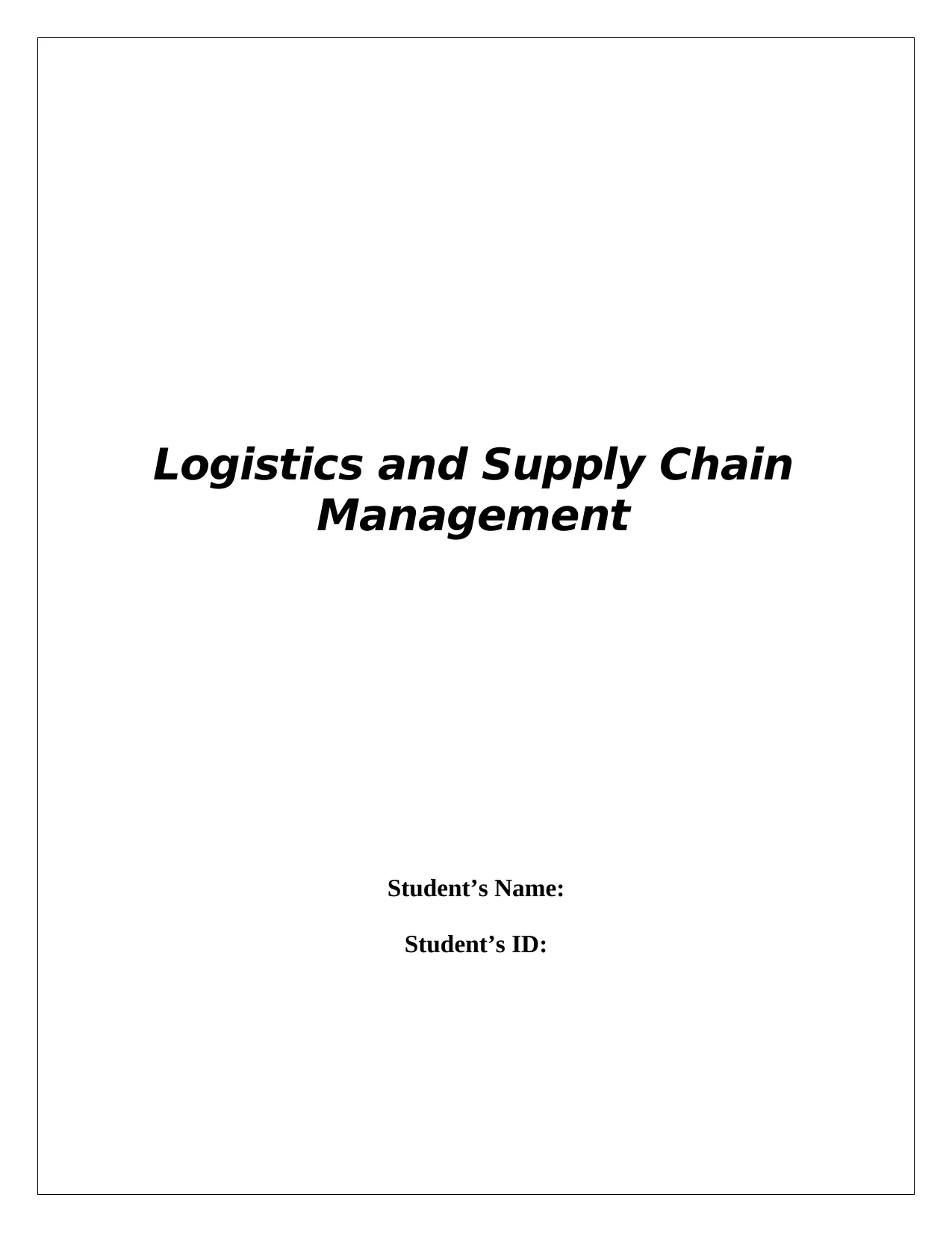
Logistics and Supply Chain
Management
Student’s Name:
Student’s ID:
Management
Student’s Name:
Student’s ID:
Paraphrase This Document
Need a fresh take? Get an instant paraphrase of this document with our AI Paraphraser
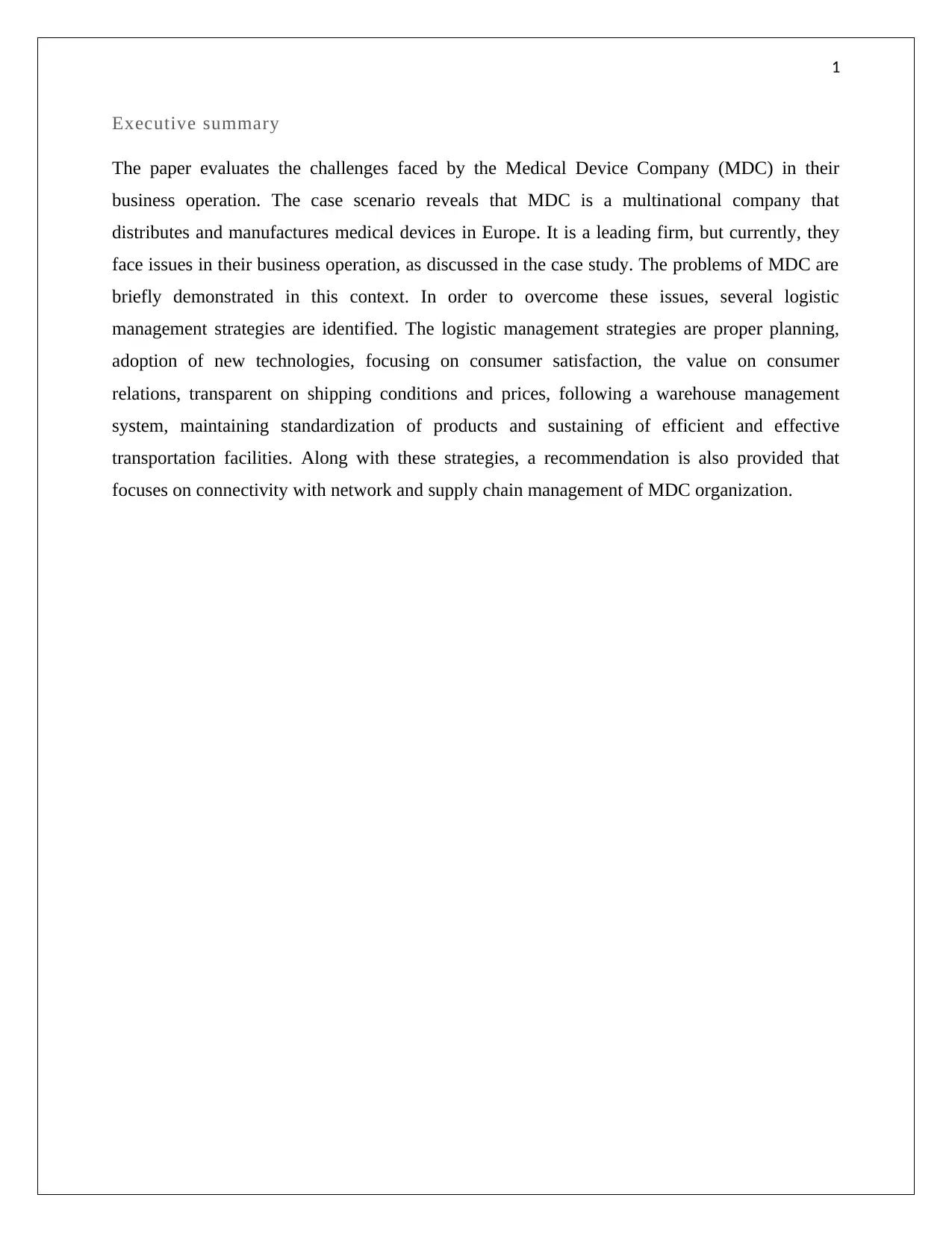
1
Executive summary
The paper evaluates the challenges faced by the Medical Device Company (MDC) in their
business operation. The case scenario reveals that MDC is a multinational company that
distributes and manufactures medical devices in Europe. It is a leading firm, but currently, they
face issues in their business operation, as discussed in the case study. The problems of MDC are
briefly demonstrated in this context. In order to overcome these issues, several logistic
management strategies are identified. The logistic management strategies are proper planning,
adoption of new technologies, focusing on consumer satisfaction, the value on consumer
relations, transparent on shipping conditions and prices, following a warehouse management
system, maintaining standardization of products and sustaining of efficient and effective
transportation facilities. Along with these strategies, a recommendation is also provided that
focuses on connectivity with network and supply chain management of MDC organization.
Executive summary
The paper evaluates the challenges faced by the Medical Device Company (MDC) in their
business operation. The case scenario reveals that MDC is a multinational company that
distributes and manufactures medical devices in Europe. It is a leading firm, but currently, they
face issues in their business operation, as discussed in the case study. The problems of MDC are
briefly demonstrated in this context. In order to overcome these issues, several logistic
management strategies are identified. The logistic management strategies are proper planning,
adoption of new technologies, focusing on consumer satisfaction, the value on consumer
relations, transparent on shipping conditions and prices, following a warehouse management
system, maintaining standardization of products and sustaining of efficient and effective
transportation facilities. Along with these strategies, a recommendation is also provided that
focuses on connectivity with network and supply chain management of MDC organization.
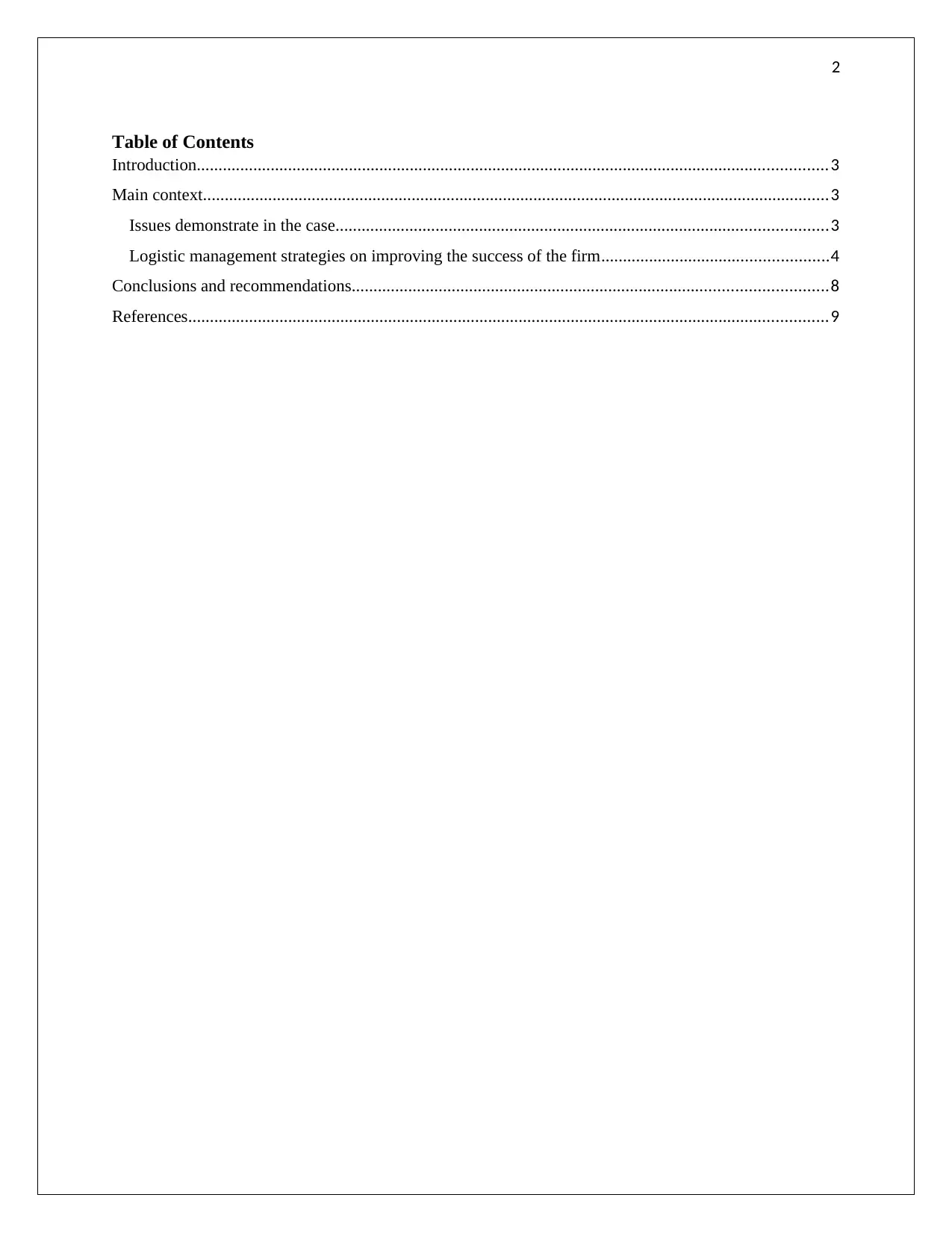
2
Table of Contents
Introduction.................................................................................................................................................3
Main context................................................................................................................................................3
Issues demonstrate in the case.................................................................................................................3
Logistic management strategies on improving the success of the firm....................................................4
Conclusions and recommendations.............................................................................................................8
References...................................................................................................................................................9
Table of Contents
Introduction.................................................................................................................................................3
Main context................................................................................................................................................3
Issues demonstrate in the case.................................................................................................................3
Logistic management strategies on improving the success of the firm....................................................4
Conclusions and recommendations.............................................................................................................8
References...................................................................................................................................................9
⊘ This is a preview!⊘
Do you want full access?
Subscribe today to unlock all pages.

Trusted by 1+ million students worldwide
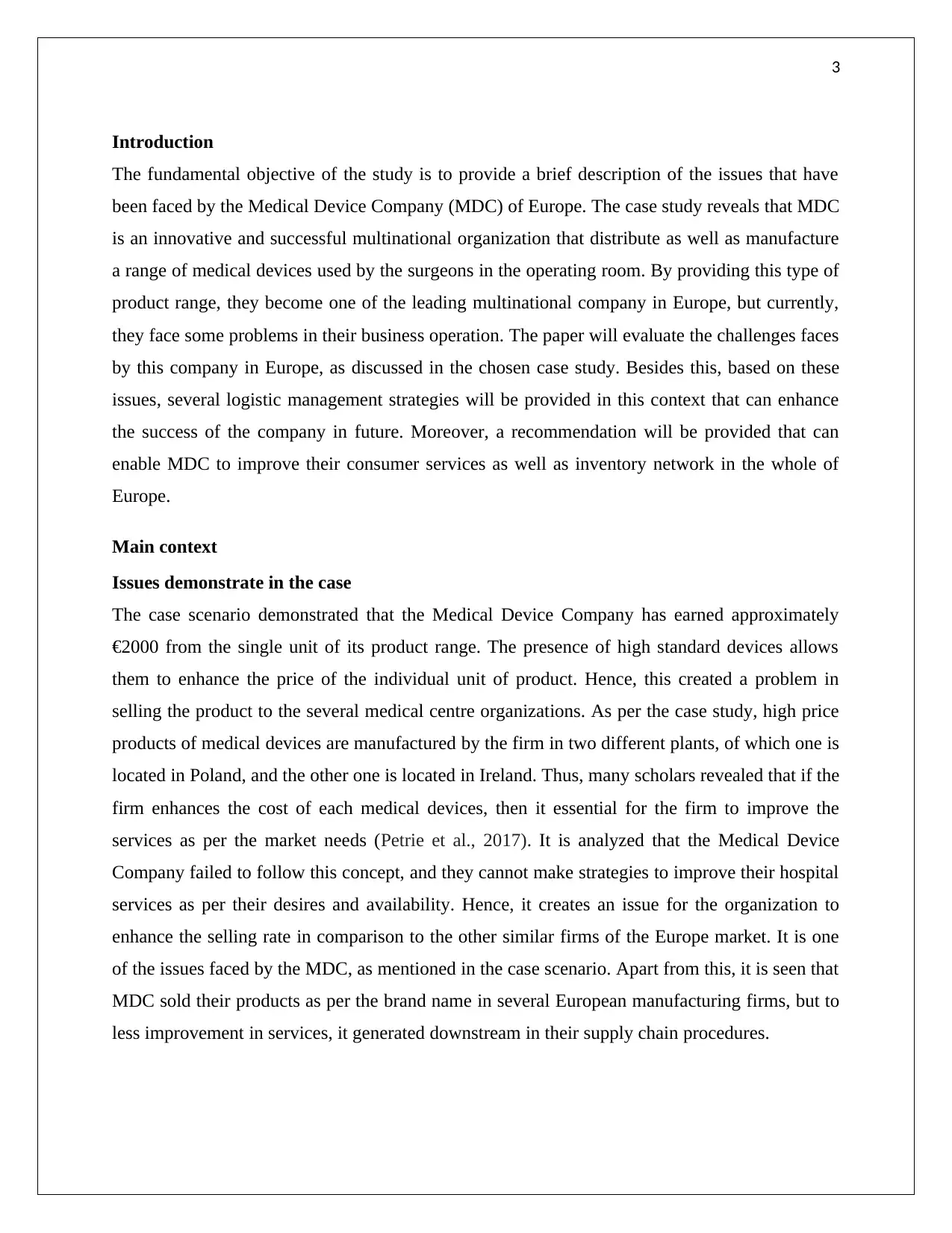
3
Introduction
The fundamental objective of the study is to provide a brief description of the issues that have
been faced by the Medical Device Company (MDC) of Europe. The case study reveals that MDC
is an innovative and successful multinational organization that distribute as well as manufacture
a range of medical devices used by the surgeons in the operating room. By providing this type of
product range, they become one of the leading multinational company in Europe, but currently,
they face some problems in their business operation. The paper will evaluate the challenges faces
by this company in Europe, as discussed in the chosen case study. Besides this, based on these
issues, several logistic management strategies will be provided in this context that can enhance
the success of the company in future. Moreover, a recommendation will be provided that can
enable MDC to improve their consumer services as well as inventory network in the whole of
Europe.
Main context
Issues demonstrate in the case
The case scenario demonstrated that the Medical Device Company has earned approximately
€2000 from the single unit of its product range. The presence of high standard devices allows
them to enhance the price of the individual unit of product. Hence, this created a problem in
selling the product to the several medical centre organizations. As per the case study, high price
products of medical devices are manufactured by the firm in two different plants, of which one is
located in Poland, and the other one is located in Ireland. Thus, many scholars revealed that if the
firm enhances the cost of each medical devices, then it essential for the firm to improve the
services as per the market needs (Petrie et al., 2017). It is analyzed that the Medical Device
Company failed to follow this concept, and they cannot make strategies to improve their hospital
services as per their desires and availability. Hence, it creates an issue for the organization to
enhance the selling rate in comparison to the other similar firms of the Europe market. It is one
of the issues faced by the MDC, as mentioned in the case scenario. Apart from this, it is seen that
MDC sold their products as per the brand name in several European manufacturing firms, but to
less improvement in services, it generated downstream in their supply chain procedures.
Introduction
The fundamental objective of the study is to provide a brief description of the issues that have
been faced by the Medical Device Company (MDC) of Europe. The case study reveals that MDC
is an innovative and successful multinational organization that distribute as well as manufacture
a range of medical devices used by the surgeons in the operating room. By providing this type of
product range, they become one of the leading multinational company in Europe, but currently,
they face some problems in their business operation. The paper will evaluate the challenges faces
by this company in Europe, as discussed in the chosen case study. Besides this, based on these
issues, several logistic management strategies will be provided in this context that can enhance
the success of the company in future. Moreover, a recommendation will be provided that can
enable MDC to improve their consumer services as well as inventory network in the whole of
Europe.
Main context
Issues demonstrate in the case
The case scenario demonstrated that the Medical Device Company has earned approximately
€2000 from the single unit of its product range. The presence of high standard devices allows
them to enhance the price of the individual unit of product. Hence, this created a problem in
selling the product to the several medical centre organizations. As per the case study, high price
products of medical devices are manufactured by the firm in two different plants, of which one is
located in Poland, and the other one is located in Ireland. Thus, many scholars revealed that if the
firm enhances the cost of each medical devices, then it essential for the firm to improve the
services as per the market needs (Petrie et al., 2017). It is analyzed that the Medical Device
Company failed to follow this concept, and they cannot make strategies to improve their hospital
services as per their desires and availability. Hence, it creates an issue for the organization to
enhance the selling rate in comparison to the other similar firms of the Europe market. It is one
of the issues faced by the MDC, as mentioned in the case scenario. Apart from this, it is seen that
MDC sold their products as per the brand name in several European manufacturing firms, but to
less improvement in services, it generated downstream in their supply chain procedures.
Paraphrase This Document
Need a fresh take? Get an instant paraphrase of this document with our AI Paraphraser
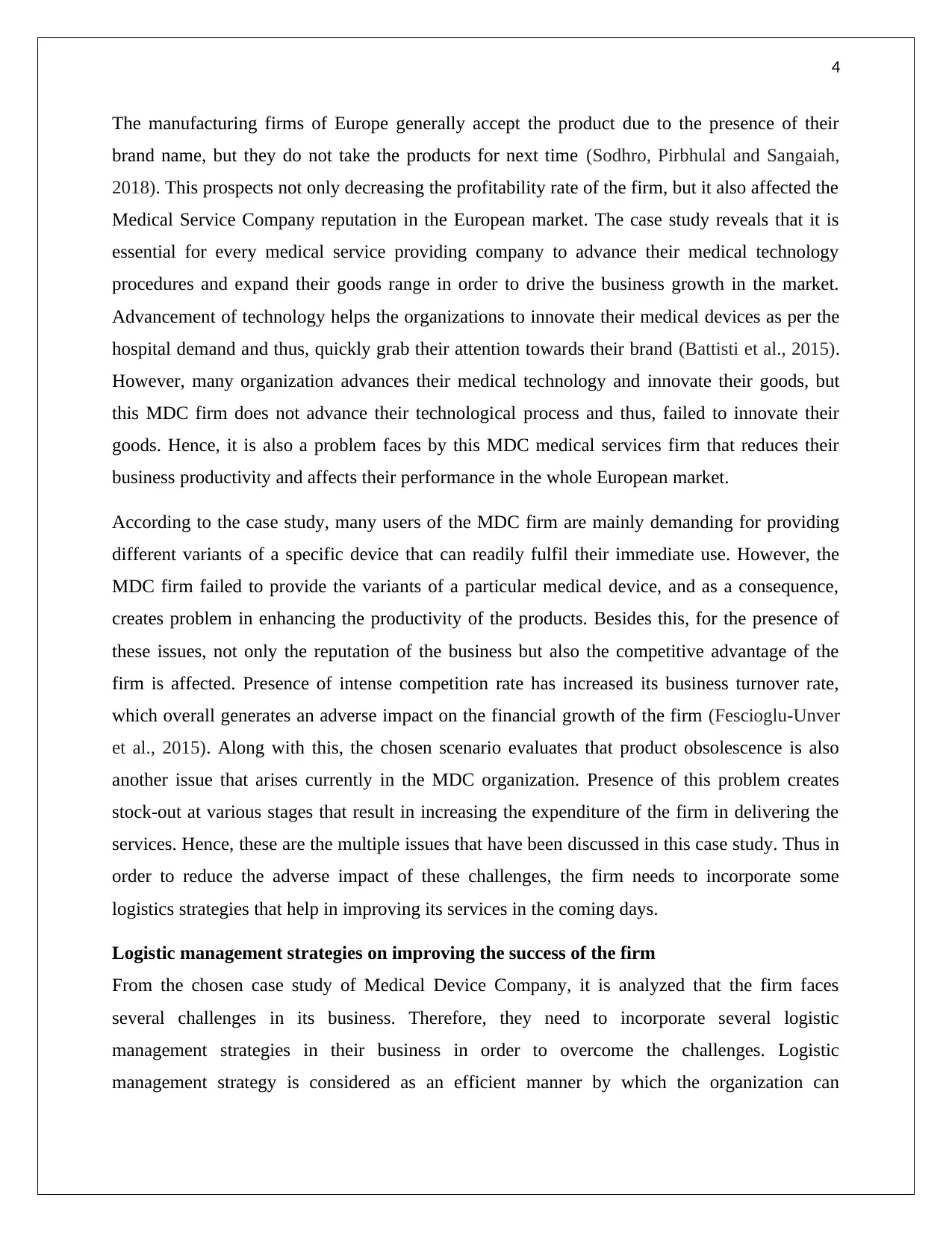
4
The manufacturing firms of Europe generally accept the product due to the presence of their
brand name, but they do not take the products for next time (Sodhro, Pirbhulal and Sangaiah,
2018). This prospects not only decreasing the profitability rate of the firm, but it also affected the
Medical Service Company reputation in the European market. The case study reveals that it is
essential for every medical service providing company to advance their medical technology
procedures and expand their goods range in order to drive the business growth in the market.
Advancement of technology helps the organizations to innovate their medical devices as per the
hospital demand and thus, quickly grab their attention towards their brand (Battisti et al., 2015).
However, many organization advances their medical technology and innovate their goods, but
this MDC firm does not advance their technological process and thus, failed to innovate their
goods. Hence, it is also a problem faces by this MDC medical services firm that reduces their
business productivity and affects their performance in the whole European market.
According to the case study, many users of the MDC firm are mainly demanding for providing
different variants of a specific device that can readily fulfil their immediate use. However, the
MDC firm failed to provide the variants of a particular medical device, and as a consequence,
creates problem in enhancing the productivity of the products. Besides this, for the presence of
these issues, not only the reputation of the business but also the competitive advantage of the
firm is affected. Presence of intense competition rate has increased its business turnover rate,
which overall generates an adverse impact on the financial growth of the firm (Fescioglu-Unver
et al., 2015). Along with this, the chosen scenario evaluates that product obsolescence is also
another issue that arises currently in the MDC organization. Presence of this problem creates
stock-out at various stages that result in increasing the expenditure of the firm in delivering the
services. Hence, these are the multiple issues that have been discussed in this case study. Thus in
order to reduce the adverse impact of these challenges, the firm needs to incorporate some
logistics strategies that help in improving its services in the coming days.
Logistic management strategies on improving the success of the firm
From the chosen case study of Medical Device Company, it is analyzed that the firm faces
several challenges in its business. Therefore, they need to incorporate several logistic
management strategies in their business in order to overcome the challenges. Logistic
management strategy is considered as an efficient manner by which the organization can
The manufacturing firms of Europe generally accept the product due to the presence of their
brand name, but they do not take the products for next time (Sodhro, Pirbhulal and Sangaiah,
2018). This prospects not only decreasing the profitability rate of the firm, but it also affected the
Medical Service Company reputation in the European market. The case study reveals that it is
essential for every medical service providing company to advance their medical technology
procedures and expand their goods range in order to drive the business growth in the market.
Advancement of technology helps the organizations to innovate their medical devices as per the
hospital demand and thus, quickly grab their attention towards their brand (Battisti et al., 2015).
However, many organization advances their medical technology and innovate their goods, but
this MDC firm does not advance their technological process and thus, failed to innovate their
goods. Hence, it is also a problem faces by this MDC medical services firm that reduces their
business productivity and affects their performance in the whole European market.
According to the case study, many users of the MDC firm are mainly demanding for providing
different variants of a specific device that can readily fulfil their immediate use. However, the
MDC firm failed to provide the variants of a particular medical device, and as a consequence,
creates problem in enhancing the productivity of the products. Besides this, for the presence of
these issues, not only the reputation of the business but also the competitive advantage of the
firm is affected. Presence of intense competition rate has increased its business turnover rate,
which overall generates an adverse impact on the financial growth of the firm (Fescioglu-Unver
et al., 2015). Along with this, the chosen scenario evaluates that product obsolescence is also
another issue that arises currently in the MDC organization. Presence of this problem creates
stock-out at various stages that result in increasing the expenditure of the firm in delivering the
services. Hence, these are the multiple issues that have been discussed in this case study. Thus in
order to reduce the adverse impact of these challenges, the firm needs to incorporate some
logistics strategies that help in improving its services in the coming days.
Logistic management strategies on improving the success of the firm
From the chosen case study of Medical Device Company, it is analyzed that the firm faces
several challenges in its business. Therefore, they need to incorporate several logistic
management strategies in their business in order to overcome the challenges. Logistic
management strategy is considered as an efficient manner by which the organization can
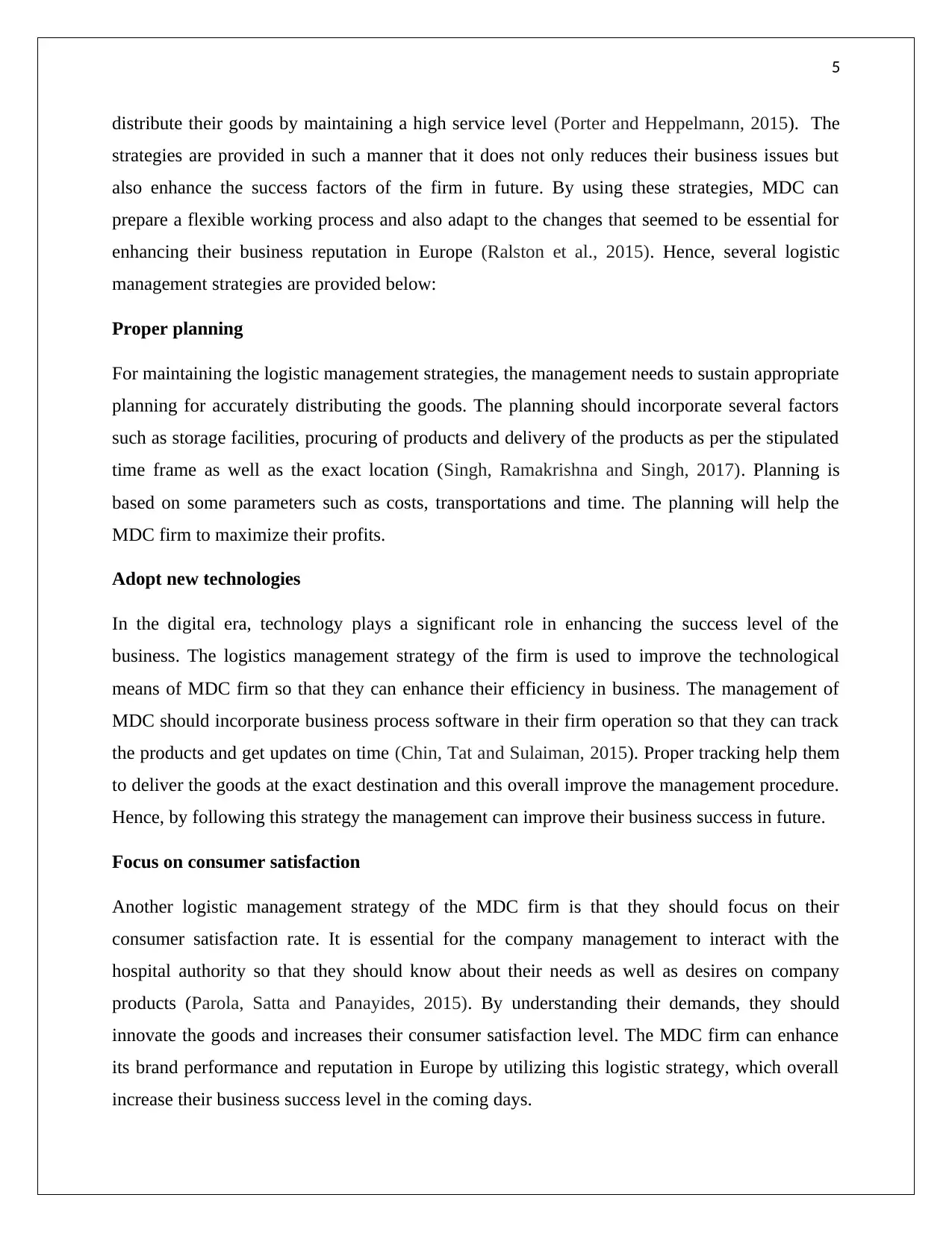
5
distribute their goods by maintaining a high service level (Porter and Heppelmann, 2015). The
strategies are provided in such a manner that it does not only reduces their business issues but
also enhance the success factors of the firm in future. By using these strategies, MDC can
prepare a flexible working process and also adapt to the changes that seemed to be essential for
enhancing their business reputation in Europe (Ralston et al., 2015). Hence, several logistic
management strategies are provided below:
Proper planning
For maintaining the logistic management strategies, the management needs to sustain appropriate
planning for accurately distributing the goods. The planning should incorporate several factors
such as storage facilities, procuring of products and delivery of the products as per the stipulated
time frame as well as the exact location (Singh, Ramakrishna and Singh, 2017). Planning is
based on some parameters such as costs, transportations and time. The planning will help the
MDC firm to maximize their profits.
Adopt new technologies
In the digital era, technology plays a significant role in enhancing the success level of the
business. The logistics management strategy of the firm is used to improve the technological
means of MDC firm so that they can enhance their efficiency in business. The management of
MDC should incorporate business process software in their firm operation so that they can track
the products and get updates on time (Chin, Tat and Sulaiman, 2015). Proper tracking help them
to deliver the goods at the exact destination and this overall improve the management procedure.
Hence, by following this strategy the management can improve their business success in future.
Focus on consumer satisfaction
Another logistic management strategy of the MDC firm is that they should focus on their
consumer satisfaction rate. It is essential for the company management to interact with the
hospital authority so that they should know about their needs as well as desires on company
products (Parola, Satta and Panayides, 2015). By understanding their demands, they should
innovate the goods and increases their consumer satisfaction level. The MDC firm can enhance
its brand performance and reputation in Europe by utilizing this logistic strategy, which overall
increase their business success level in the coming days.
distribute their goods by maintaining a high service level (Porter and Heppelmann, 2015). The
strategies are provided in such a manner that it does not only reduces their business issues but
also enhance the success factors of the firm in future. By using these strategies, MDC can
prepare a flexible working process and also adapt to the changes that seemed to be essential for
enhancing their business reputation in Europe (Ralston et al., 2015). Hence, several logistic
management strategies are provided below:
Proper planning
For maintaining the logistic management strategies, the management needs to sustain appropriate
planning for accurately distributing the goods. The planning should incorporate several factors
such as storage facilities, procuring of products and delivery of the products as per the stipulated
time frame as well as the exact location (Singh, Ramakrishna and Singh, 2017). Planning is
based on some parameters such as costs, transportations and time. The planning will help the
MDC firm to maximize their profits.
Adopt new technologies
In the digital era, technology plays a significant role in enhancing the success level of the
business. The logistics management strategy of the firm is used to improve the technological
means of MDC firm so that they can enhance their efficiency in business. The management of
MDC should incorporate business process software in their firm operation so that they can track
the products and get updates on time (Chin, Tat and Sulaiman, 2015). Proper tracking help them
to deliver the goods at the exact destination and this overall improve the management procedure.
Hence, by following this strategy the management can improve their business success in future.
Focus on consumer satisfaction
Another logistic management strategy of the MDC firm is that they should focus on their
consumer satisfaction rate. It is essential for the company management to interact with the
hospital authority so that they should know about their needs as well as desires on company
products (Parola, Satta and Panayides, 2015). By understanding their demands, they should
innovate the goods and increases their consumer satisfaction level. The MDC firm can enhance
its brand performance and reputation in Europe by utilizing this logistic strategy, which overall
increase their business success level in the coming days.
⊘ This is a preview!⊘
Do you want full access?
Subscribe today to unlock all pages.

Trusted by 1+ million students worldwide

6
Paraphrase This Document
Need a fresh take? Get an instant paraphrase of this document with our AI Paraphraser
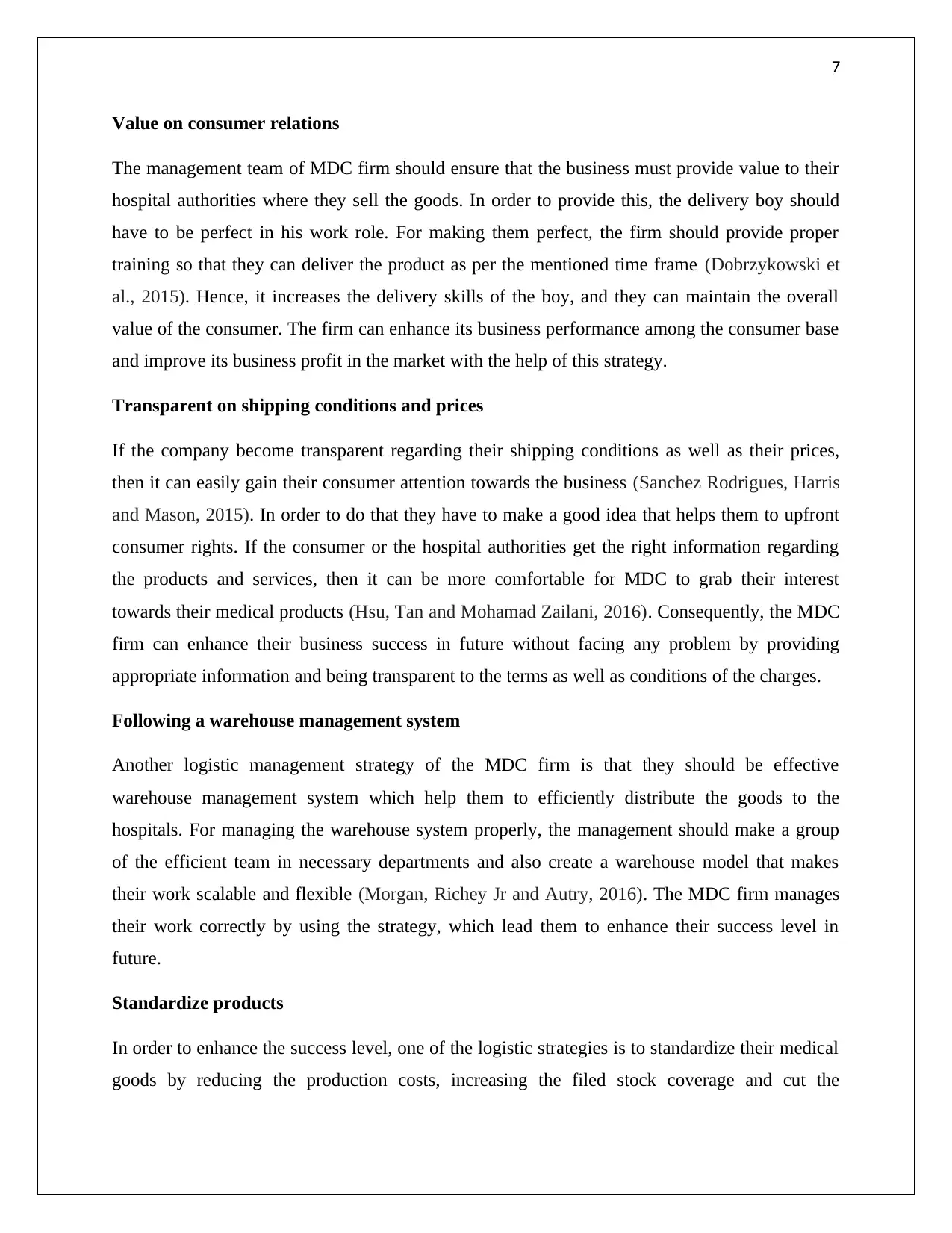
7
Value on consumer relations
The management team of MDC firm should ensure that the business must provide value to their
hospital authorities where they sell the goods. In order to provide this, the delivery boy should
have to be perfect in his work role. For making them perfect, the firm should provide proper
training so that they can deliver the product as per the mentioned time frame (Dobrzykowski et
al., 2015). Hence, it increases the delivery skills of the boy, and they can maintain the overall
value of the consumer. The firm can enhance its business performance among the consumer base
and improve its business profit in the market with the help of this strategy.
Transparent on shipping conditions and prices
If the company become transparent regarding their shipping conditions as well as their prices,
then it can easily gain their consumer attention towards the business (Sanchez Rodrigues, Harris
and Mason, 2015). In order to do that they have to make a good idea that helps them to upfront
consumer rights. If the consumer or the hospital authorities get the right information regarding
the products and services, then it can be more comfortable for MDC to grab their interest
towards their medical products (Hsu, Tan and Mohamad Zailani, 2016). Consequently, the MDC
firm can enhance their business success in future without facing any problem by providing
appropriate information and being transparent to the terms as well as conditions of the charges.
Following a warehouse management system
Another logistic management strategy of the MDC firm is that they should be effective
warehouse management system which help them to efficiently distribute the goods to the
hospitals. For managing the warehouse system properly, the management should make a group
of the efficient team in necessary departments and also create a warehouse model that makes
their work scalable and flexible (Morgan, Richey Jr and Autry, 2016). The MDC firm manages
their work correctly by using the strategy, which lead them to enhance their success level in
future.
Standardize products
In order to enhance the success level, one of the logistic strategies is to standardize their medical
goods by reducing the production costs, increasing the filed stock coverage and cut the
Value on consumer relations
The management team of MDC firm should ensure that the business must provide value to their
hospital authorities where they sell the goods. In order to provide this, the delivery boy should
have to be perfect in his work role. For making them perfect, the firm should provide proper
training so that they can deliver the product as per the mentioned time frame (Dobrzykowski et
al., 2015). Hence, it increases the delivery skills of the boy, and they can maintain the overall
value of the consumer. The firm can enhance its business performance among the consumer base
and improve its business profit in the market with the help of this strategy.
Transparent on shipping conditions and prices
If the company become transparent regarding their shipping conditions as well as their prices,
then it can easily gain their consumer attention towards the business (Sanchez Rodrigues, Harris
and Mason, 2015). In order to do that they have to make a good idea that helps them to upfront
consumer rights. If the consumer or the hospital authorities get the right information regarding
the products and services, then it can be more comfortable for MDC to grab their interest
towards their medical products (Hsu, Tan and Mohamad Zailani, 2016). Consequently, the MDC
firm can enhance their business success in future without facing any problem by providing
appropriate information and being transparent to the terms as well as conditions of the charges.
Following a warehouse management system
Another logistic management strategy of the MDC firm is that they should be effective
warehouse management system which help them to efficiently distribute the goods to the
hospitals. For managing the warehouse system properly, the management should make a group
of the efficient team in necessary departments and also create a warehouse model that makes
their work scalable and flexible (Morgan, Richey Jr and Autry, 2016). The MDC firm manages
their work correctly by using the strategy, which lead them to enhance their success level in
future.
Standardize products
In order to enhance the success level, one of the logistic strategies is to standardize their medical
goods by reducing the production costs, increasing the filed stock coverage and cut the
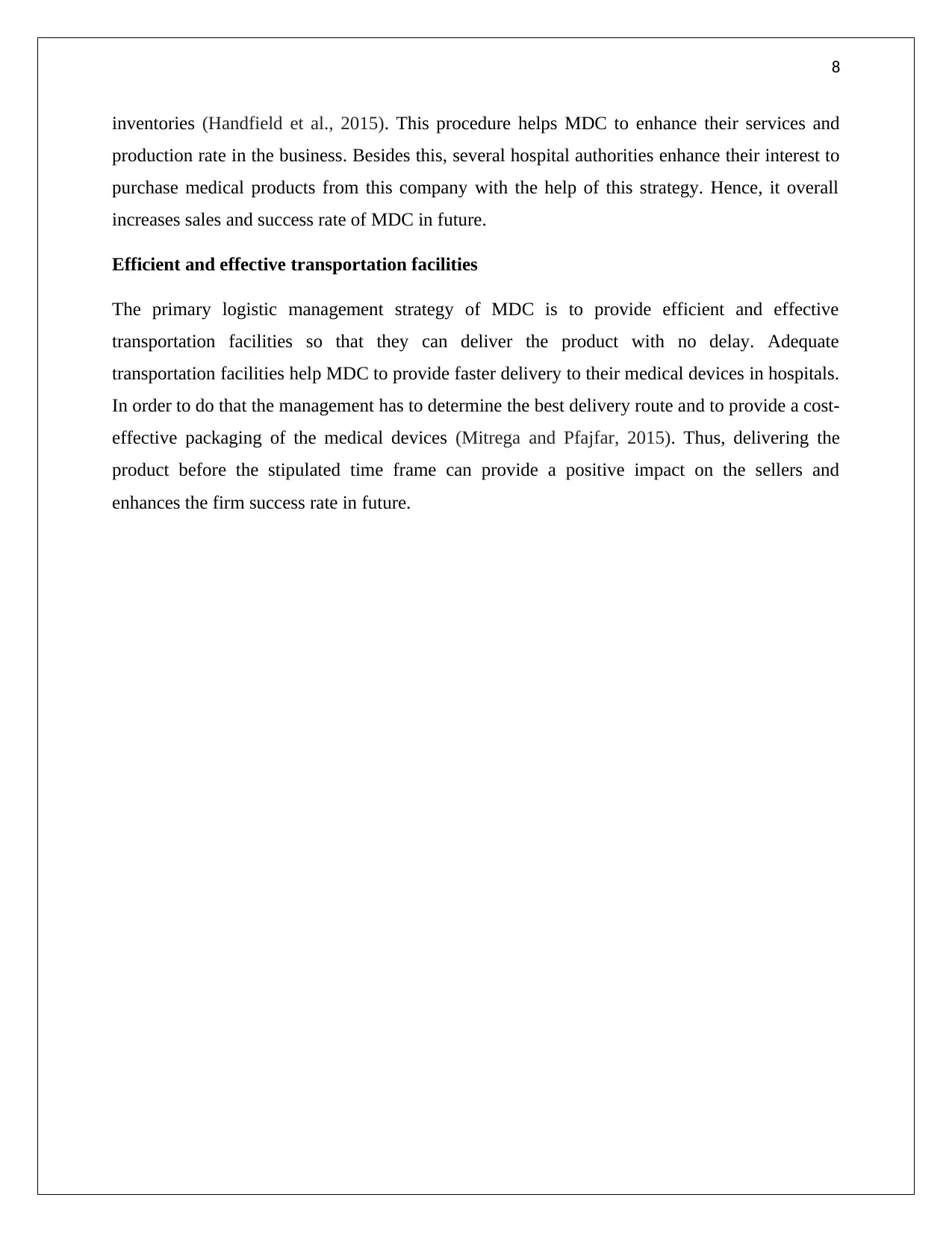
8
inventories (Handfield et al., 2015). This procedure helps MDC to enhance their services and
production rate in the business. Besides this, several hospital authorities enhance their interest to
purchase medical products from this company with the help of this strategy. Hence, it overall
increases sales and success rate of MDC in future.
Efficient and effective transportation facilities
The primary logistic management strategy of MDC is to provide efficient and effective
transportation facilities so that they can deliver the product with no delay. Adequate
transportation facilities help MDC to provide faster delivery to their medical devices in hospitals.
In order to do that the management has to determine the best delivery route and to provide a cost-
effective packaging of the medical devices (Mitrega and Pfajfar, 2015). Thus, delivering the
product before the stipulated time frame can provide a positive impact on the sellers and
enhances the firm success rate in future.
inventories (Handfield et al., 2015). This procedure helps MDC to enhance their services and
production rate in the business. Besides this, several hospital authorities enhance their interest to
purchase medical products from this company with the help of this strategy. Hence, it overall
increases sales and success rate of MDC in future.
Efficient and effective transportation facilities
The primary logistic management strategy of MDC is to provide efficient and effective
transportation facilities so that they can deliver the product with no delay. Adequate
transportation facilities help MDC to provide faster delivery to their medical devices in hospitals.
In order to do that the management has to determine the best delivery route and to provide a cost-
effective packaging of the medical devices (Mitrega and Pfajfar, 2015). Thus, delivering the
product before the stipulated time frame can provide a positive impact on the sellers and
enhances the firm success rate in future.
⊘ This is a preview!⊘
Do you want full access?
Subscribe today to unlock all pages.

Trusted by 1+ million students worldwide
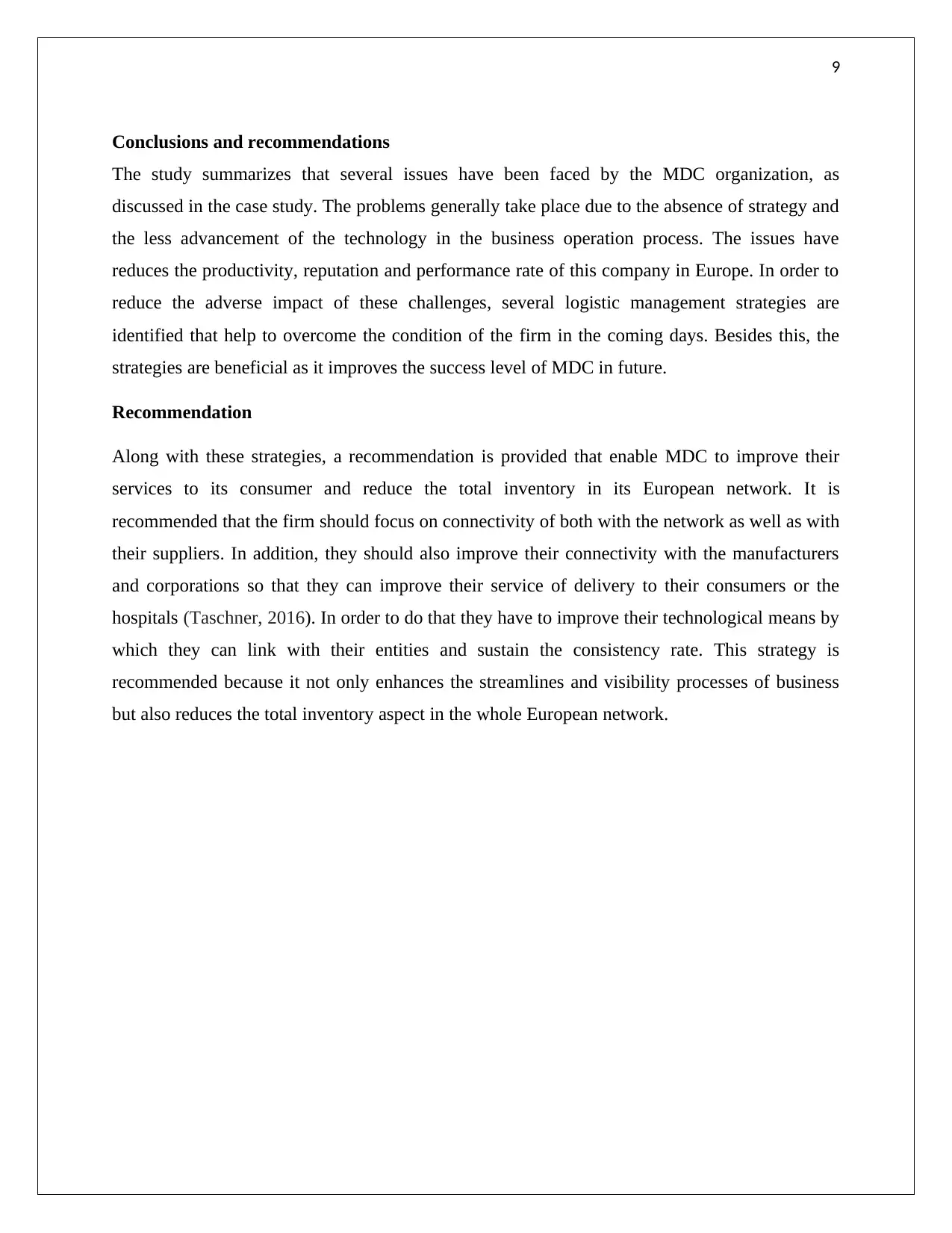
9
Conclusions and recommendations
The study summarizes that several issues have been faced by the MDC organization, as
discussed in the case study. The problems generally take place due to the absence of strategy and
the less advancement of the technology in the business operation process. The issues have
reduces the productivity, reputation and performance rate of this company in Europe. In order to
reduce the adverse impact of these challenges, several logistic management strategies are
identified that help to overcome the condition of the firm in the coming days. Besides this, the
strategies are beneficial as it improves the success level of MDC in future.
Recommendation
Along with these strategies, a recommendation is provided that enable MDC to improve their
services to its consumer and reduce the total inventory in its European network. It is
recommended that the firm should focus on connectivity of both with the network as well as with
their suppliers. In addition, they should also improve their connectivity with the manufacturers
and corporations so that they can improve their service of delivery to their consumers or the
hospitals (Taschner, 2016). In order to do that they have to improve their technological means by
which they can link with their entities and sustain the consistency rate. This strategy is
recommended because it not only enhances the streamlines and visibility processes of business
but also reduces the total inventory aspect in the whole European network.
Conclusions and recommendations
The study summarizes that several issues have been faced by the MDC organization, as
discussed in the case study. The problems generally take place due to the absence of strategy and
the less advancement of the technology in the business operation process. The issues have
reduces the productivity, reputation and performance rate of this company in Europe. In order to
reduce the adverse impact of these challenges, several logistic management strategies are
identified that help to overcome the condition of the firm in the coming days. Besides this, the
strategies are beneficial as it improves the success level of MDC in future.
Recommendation
Along with these strategies, a recommendation is provided that enable MDC to improve their
services to its consumer and reduce the total inventory in its European network. It is
recommended that the firm should focus on connectivity of both with the network as well as with
their suppliers. In addition, they should also improve their connectivity with the manufacturers
and corporations so that they can improve their service of delivery to their consumers or the
hospitals (Taschner, 2016). In order to do that they have to improve their technological means by
which they can link with their entities and sustain the consistency rate. This strategy is
recommended because it not only enhances the streamlines and visibility processes of business
but also reduces the total inventory aspect in the whole European network.
Paraphrase This Document
Need a fresh take? Get an instant paraphrase of this document with our AI Paraphraser
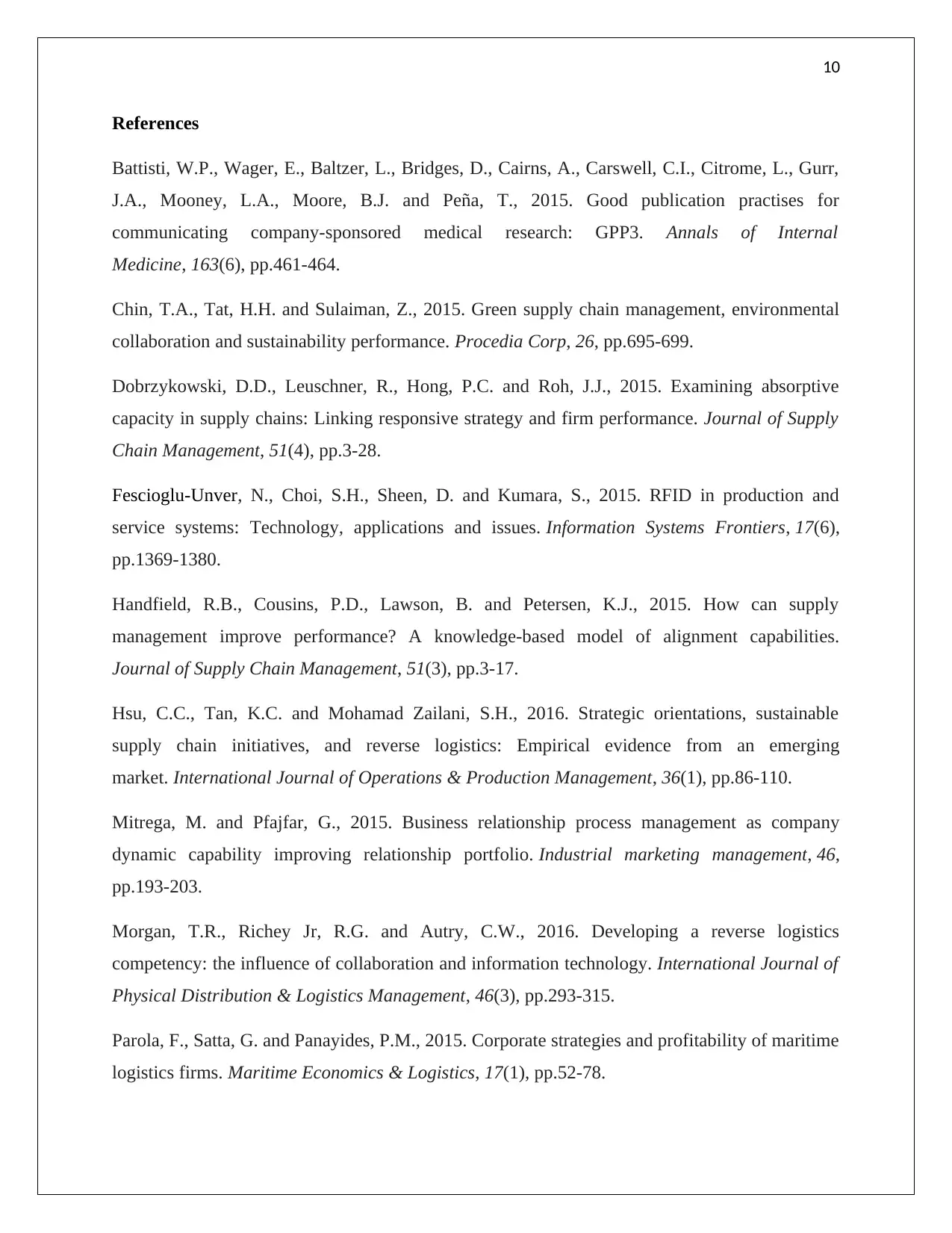
10
References
Battisti, W.P., Wager, E., Baltzer, L., Bridges, D., Cairns, A., Carswell, C.I., Citrome, L., Gurr,
J.A., Mooney, L.A., Moore, B.J. and Peña, T., 2015. Good publication practises for
communicating company-sponsored medical research: GPP3. Annals of Internal
Medicine, 163(6), pp.461-464.
Chin, T.A., Tat, H.H. and Sulaiman, Z., 2015. Green supply chain management, environmental
collaboration and sustainability performance. Procedia Corp, 26, pp.695-699.
Dobrzykowski, D.D., Leuschner, R., Hong, P.C. and Roh, J.J., 2015. Examining absorptive
capacity in supply chains: Linking responsive strategy and firm performance. Journal of Supply
Chain Management, 51(4), pp.3-28.
Fescioglu-Unver, N., Choi, S.H., Sheen, D. and Kumara, S., 2015. RFID in production and
service systems: Technology, applications and issues. Information Systems Frontiers, 17(6),
pp.1369-1380.
Handfield, R.B., Cousins, P.D., Lawson, B. and Petersen, K.J., 2015. How can supply
management improve performance? A knowledge‐based model of alignment capabilities.
Journal of Supply Chain Management, 51(3), pp.3-17.
Hsu, C.C., Tan, K.C. and Mohamad Zailani, S.H., 2016. Strategic orientations, sustainable
supply chain initiatives, and reverse logistics: Empirical evidence from an emerging
market. International Journal of Operations & Production Management, 36(1), pp.86-110.
Mitrega, M. and Pfajfar, G., 2015. Business relationship process management as company
dynamic capability improving relationship portfolio. Industrial marketing management, 46,
pp.193-203.
Morgan, T.R., Richey Jr, R.G. and Autry, C.W., 2016. Developing a reverse logistics
competency: the influence of collaboration and information technology. International Journal of
Physical Distribution & Logistics Management, 46(3), pp.293-315.
Parola, F., Satta, G. and Panayides, P.M., 2015. Corporate strategies and profitability of maritime
logistics firms. Maritime Economics & Logistics, 17(1), pp.52-78.
References
Battisti, W.P., Wager, E., Baltzer, L., Bridges, D., Cairns, A., Carswell, C.I., Citrome, L., Gurr,
J.A., Mooney, L.A., Moore, B.J. and Peña, T., 2015. Good publication practises for
communicating company-sponsored medical research: GPP3. Annals of Internal
Medicine, 163(6), pp.461-464.
Chin, T.A., Tat, H.H. and Sulaiman, Z., 2015. Green supply chain management, environmental
collaboration and sustainability performance. Procedia Corp, 26, pp.695-699.
Dobrzykowski, D.D., Leuschner, R., Hong, P.C. and Roh, J.J., 2015. Examining absorptive
capacity in supply chains: Linking responsive strategy and firm performance. Journal of Supply
Chain Management, 51(4), pp.3-28.
Fescioglu-Unver, N., Choi, S.H., Sheen, D. and Kumara, S., 2015. RFID in production and
service systems: Technology, applications and issues. Information Systems Frontiers, 17(6),
pp.1369-1380.
Handfield, R.B., Cousins, P.D., Lawson, B. and Petersen, K.J., 2015. How can supply
management improve performance? A knowledge‐based model of alignment capabilities.
Journal of Supply Chain Management, 51(3), pp.3-17.
Hsu, C.C., Tan, K.C. and Mohamad Zailani, S.H., 2016. Strategic orientations, sustainable
supply chain initiatives, and reverse logistics: Empirical evidence from an emerging
market. International Journal of Operations & Production Management, 36(1), pp.86-110.
Mitrega, M. and Pfajfar, G., 2015. Business relationship process management as company
dynamic capability improving relationship portfolio. Industrial marketing management, 46,
pp.193-203.
Morgan, T.R., Richey Jr, R.G. and Autry, C.W., 2016. Developing a reverse logistics
competency: the influence of collaboration and information technology. International Journal of
Physical Distribution & Logistics Management, 46(3), pp.293-315.
Parola, F., Satta, G. and Panayides, P.M., 2015. Corporate strategies and profitability of maritime
logistics firms. Maritime Economics & Logistics, 17(1), pp.52-78.
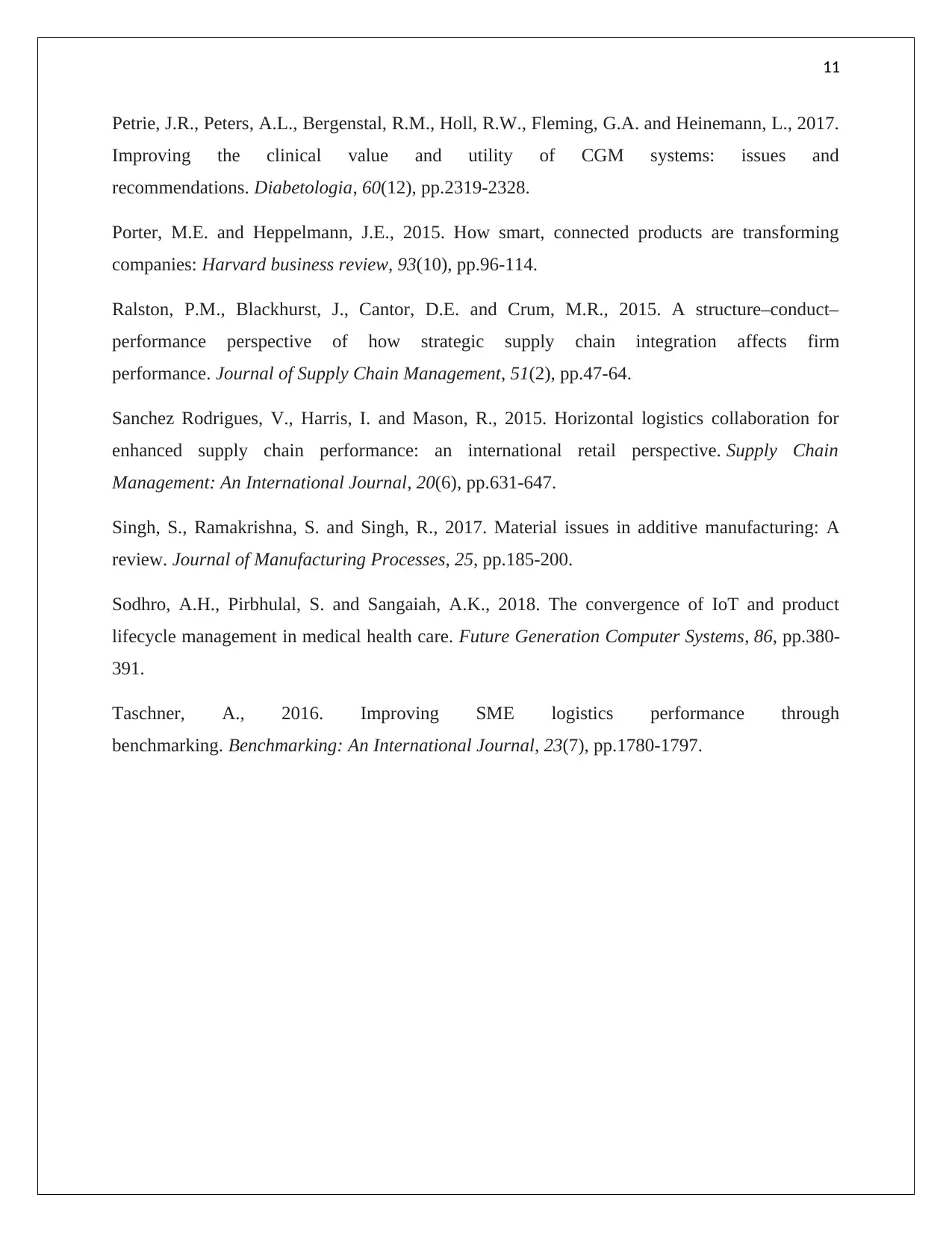
11
Petrie, J.R., Peters, A.L., Bergenstal, R.M., Holl, R.W., Fleming, G.A. and Heinemann, L., 2017.
Improving the clinical value and utility of CGM systems: issues and
recommendations. Diabetologia, 60(12), pp.2319-2328.
Porter, M.E. and Heppelmann, J.E., 2015. How smart, connected products are transforming
companies: Harvard business review, 93(10), pp.96-114.
Ralston, P.M., Blackhurst, J., Cantor, D.E. and Crum, M.R., 2015. A structure–conduct–
performance perspective of how strategic supply chain integration affects firm
performance. Journal of Supply Chain Management, 51(2), pp.47-64.
Sanchez Rodrigues, V., Harris, I. and Mason, R., 2015. Horizontal logistics collaboration for
enhanced supply chain performance: an international retail perspective. Supply Chain
Management: An International Journal, 20(6), pp.631-647.
Singh, S., Ramakrishna, S. and Singh, R., 2017. Material issues in additive manufacturing: A
review. Journal of Manufacturing Processes, 25, pp.185-200.
Sodhro, A.H., Pirbhulal, S. and Sangaiah, A.K., 2018. The convergence of IoT and product
lifecycle management in medical health care. Future Generation Computer Systems, 86, pp.380-
391.
Taschner, A., 2016. Improving SME logistics performance through
benchmarking. Benchmarking: An International Journal, 23(7), pp.1780-1797.
Petrie, J.R., Peters, A.L., Bergenstal, R.M., Holl, R.W., Fleming, G.A. and Heinemann, L., 2017.
Improving the clinical value and utility of CGM systems: issues and
recommendations. Diabetologia, 60(12), pp.2319-2328.
Porter, M.E. and Heppelmann, J.E., 2015. How smart, connected products are transforming
companies: Harvard business review, 93(10), pp.96-114.
Ralston, P.M., Blackhurst, J., Cantor, D.E. and Crum, M.R., 2015. A structure–conduct–
performance perspective of how strategic supply chain integration affects firm
performance. Journal of Supply Chain Management, 51(2), pp.47-64.
Sanchez Rodrigues, V., Harris, I. and Mason, R., 2015. Horizontal logistics collaboration for
enhanced supply chain performance: an international retail perspective. Supply Chain
Management: An International Journal, 20(6), pp.631-647.
Singh, S., Ramakrishna, S. and Singh, R., 2017. Material issues in additive manufacturing: A
review. Journal of Manufacturing Processes, 25, pp.185-200.
Sodhro, A.H., Pirbhulal, S. and Sangaiah, A.K., 2018. The convergence of IoT and product
lifecycle management in medical health care. Future Generation Computer Systems, 86, pp.380-
391.
Taschner, A., 2016. Improving SME logistics performance through
benchmarking. Benchmarking: An International Journal, 23(7), pp.1780-1797.
⊘ This is a preview!⊘
Do you want full access?
Subscribe today to unlock all pages.

Trusted by 1+ million students worldwide
1 out of 12
Related Documents
Your All-in-One AI-Powered Toolkit for Academic Success.
+13062052269
info@desklib.com
Available 24*7 on WhatsApp / Email
![[object Object]](/_next/static/media/star-bottom.7253800d.svg)
Unlock your academic potential
Copyright © 2020–2025 A2Z Services. All Rights Reserved. Developed and managed by ZUCOL.





